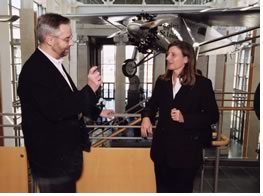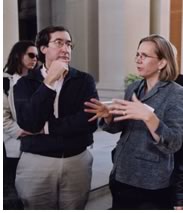
HOK Sustainable Design "Boot Camp" Enables Firm Designers
to Share Green Ideas

Associate Editor
Program Description
More than 50 Hellmuth, Obata + Kassabaum designers, project managers,
and leaders from the firm's 25 worldwide offices gathered last year in
St. Louis to participate in a three-day sustainable design "boot
camp" to share knowledge and experiences and to explore ways to continue
to integrate sustainable design practices throughout the firm.
Reason for the program
"Green buildings create higher quality buildings," Sandy F.
Mendler, AIA, HOK San Francisco sustainable design principal, said. The
added value is that they reduce costs over time, are more pleasant places
to be in, and encourage flexibility. She said that while about half the
successful green projects are for clients who have come to the firm seeking
such expertise, the other half are for clients who come to see the benefits
of sustainable design as HOK's design teams work through the projects.
 The
boot camp is an extension of the firm's existing efforts to expand awareness
about sustainable design issues as they relate to the built environment.
Mendler and HOK St. Louis sustainable design principal and colleague Bill
Odell, AIA, collaborated on The HOK Guidebook
to Sustainable Design (John Wiley & Sons, 2000), which began
as an in-house document. It is now available to the public and in its
third printing. The firm also maintains a Web site, www.hoksustainabledesign.com,
as well as an internal Web site, which is divided into three sections:
people, projects, and process. This catalogue allows designers to find
people with specific sustainable design expertise, case studies, and the
tools, resources, and information that can help them learn from parallel
projects.
The
boot camp is an extension of the firm's existing efforts to expand awareness
about sustainable design issues as they relate to the built environment.
Mendler and HOK St. Louis sustainable design principal and colleague Bill
Odell, AIA, collaborated on The HOK Guidebook
to Sustainable Design (John Wiley & Sons, 2000), which began
as an in-house document. It is now available to the public and in its
third printing. The firm also maintains a Web site, www.hoksustainabledesign.com,
as well as an internal Web site, which is divided into three sections:
people, projects, and process. This catalogue allows designers to find
people with specific sustainable design expertise, case studies, and the
tools, resources, and information that can help them learn from parallel
projects.
How it was developed
"As one of the world's largest and most far-reaching A/E firms, HOK
is in a position to have a significant impact on preserving our environment
and helping to lead the entire design and construction industry toward
sustainability," Mendler said.
 Program
organizers selected participants in leadership positions, each of whom
made a commitment to return to his or her office and share the knowledge
that was garnered during the sustainable design seminars, in a "train
the trainer" approach, Mendler said. All the participants had a higher
level of interest, involvement, and knowledge. For example, Larry Malcic,
director of design of HOK London and lead designer of a building named
the Best Commercial Workplace in Britain, was one of the attendees.
Program
organizers selected participants in leadership positions, each of whom
made a commitment to return to his or her office and share the knowledge
that was garnered during the sustainable design seminars, in a "train
the trainer" approach, Mendler said. All the participants had a higher
level of interest, involvement, and knowledge. For example, Larry Malcic,
director of design of HOK London and lead designer of a building named
the Best Commercial Workplace in Britain, was one of the attendees.
"The group's diversity drove the discussion, reinforcing the fact that sustainability spans geography, culture, industry, and building type," HOK organizers said.
Program activities
The program included:
• Interactive presentations on topics including "The Business
Case for Sustainability" "New Urbanism" and "Indoor
Environmental Quality"
• A comprehensive review of the LEED (Leadership in Energy and Environmental
Design) rating system
• A materials fair with displays and information about a wide range
of energy-efficient and environmentally responsible building materials
• Field trips to local sustainable design projects
• Keynote address by a leading advocate of conservation and biodiversity.
 Some
"green" projects in the works at HOK
Some
"green" projects in the works at HOK
• HOK architects working on the Whitehead Research Building, Emory
University, Atlanta, were informed, after construction had already begun,
that the school was aiming for LEED certification for the building. The
team discovered that its standard design practice had already positioned
them well within striking distance of this goal.
• Firm designers are working on green approaches to solving parking
problems at Dallas-Fort Worth International Airport. The 600,000-square-foot-project
is making strides in sustainable development practices in other areas
as well.
• Another HOK design, 40 Grosvenor Place, was named the Best Commercial
Workplace in Britain by the British Council for Offices. Larry Malcic,
director of design at HOK London, served as lead designer on the project.
He also attended the sustainable design workshop.
|
A summary of HOK's projects, insights, and success stories is published in the bimonthly HOK Sustainable Design Newsletter. The HOK Guidebook to Sustainable Design, (John Wiley & Sons, 2000) by Sandra F. Mendler, AIA, and William Odell, AIA, is available through the firm's Web site for $75. The publication discusses the issues surrounding sustainable design, case studies, best practices, and design strategies. Photos courtesy of Hellmuth, Obata + Kassabaum |
|
|
Putting Sustainable Design into Practice HOK has compiled a guide to "10 simple things you can do without sacrificing budget, schedule, or program considerations." The tips are explained in more detail on HOK's Web site, and in The HOK Guidebook to Sustainable Development (John Wiley & Sons), but the general themes have been reprinted, with permission, here. 1. Select and develop sites to promote livable communities. 2. Develop flexible designs to enhance building longevity. 3. Use natural strategies to protect and restore water resources. 4. Improve energy efficiency while ensuring thermal comfort. 5. Reduce environmental impacts related to energy use. 6. Promote occupant health and well-being in the indoor environment. 7. Conserve water and consider water reuse systems. 8. Use environmentally preferable building materials. 9. Use appropriate plant material. 10. Plan for recycling during construction, demolition, and occupancy. |
||
Copyright 2001 The American Institute of Architects. All rights reserved.
![]()